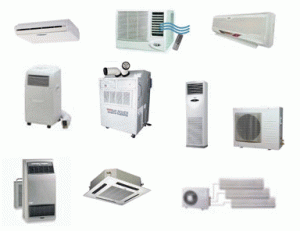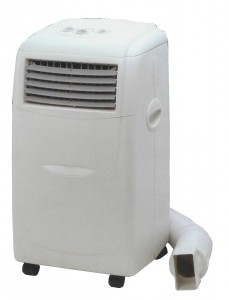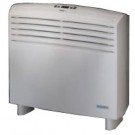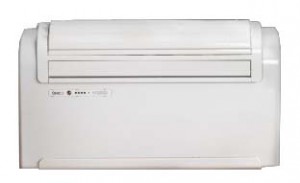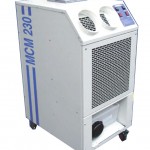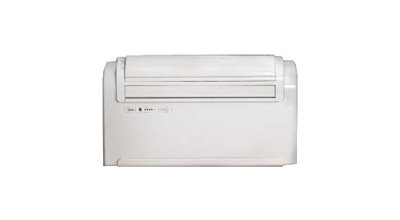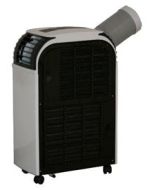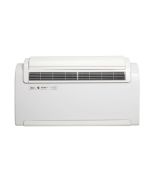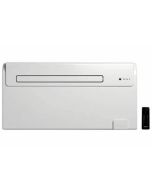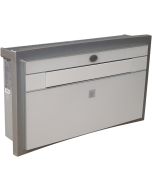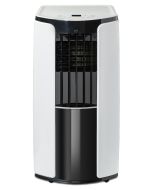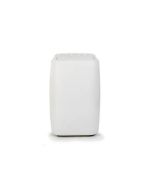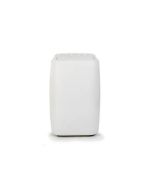The task of buying an air conditioning system for the first time can be baffling. To help, the following is a brief guide to the different air conditioning types that use refrigerant to move heat energy from inside to outside. There are other types generically called chillers, which use water for the same purpose, however we will not cover chillers on this guide.
Air Conditioning Types - Typical Capacity Ranges
Like many types of equipment, air conditioning is often split into groups which described by suitability to different users for instance residential, domestic, commercial, office and industrial. These groupings generally indicate the units size, capability and robustness, rather than how the air conditioner functions. As a rough guide the following table indicates the typical capacity ranges to these generic groups.
| Air conditioner - User type | Cooling Capacity in BTU | Cooling Capacity in kw |
| Residential / domestic, | 6000 - 20000 | 1.76 - 5.8 |
| commercial / office | 12000 - 50000 | 3.5 - 14.65 |
| Industrial | 30000 - | 8.79 - |
Air Conditioning Types - The Main Groups
Air conditioners fall into one of three major groups; they are either...
• monoblock, i.e units consisting of one block (window air conditioner, portable, etc.)
• split-systems which have an element for inside and a separate but linked element for outside the building
• multi-split where for a single outdoor element there are 2 or more linked internal elements
MONOBLOCK AIR CONDITIONERS
The operation of an air conditioner basically revolves round the flow of refrigerant from one set of coils where it collects heat to a second set of coils where it disperses heat. In monoblock air conditioners the two sets of coils are combined in the same body shell. The units are designed to be located inside the building, however they always have an air pipe to link to outside so that the heated air can be dispersed to outside.
Portable or mobile air conditionersPerhaps the most familiar air conditioner to most consumers, these units do not require special mounting but do come with a flexible air pipe which is routed through a window or hole in the wall. Generally the diameter of the air pipe is about 5" and the pipes are about 2 - 3 m long. The air conditioner discharges hot through this pipe when in use. Because the compressor is located inside the unit rather than in the case of split units, in an external element, the mobile monoblock air conditioners have the disadvantage of being quite noisy and limited in capacity. On the other hand they do not require installation and are these days relatively cheap to buy. Although there are numerous mobile air conditioners on the market, the vast majority are small units either 9000 or 12000 btu, we only sell mobile units larger than 10000 btu, simply because for the vast majority of applications 9000 btu models are just too small. | |
Floor mounted air conditionersFloor mounted monoblock air conditioners are installed against the wall in the same way a storage heater is and they are typically of a similar appearance and size to storage heaters. These type of air conditioners usually have a heat pump facility, thus providing very cost-effective heating in colder months. These air conditioners typically have 2 air pipes which lead directly from the rear of the unit, through the wall, where the ends are usually capped with small louvres. | |
Wall air conditionersSome times called high wall air conditioners, wall mounted monoblock air conditioning is a neat solution to older buildings where planning does not permit the installation of an external condenser unit. The wall mounted monoblock air conditioner pattachesp high on the wall and two air pipes are routed from the back directly through the wall. The disadvantage of these air conditioners is that they are slightly larger in-depth compared to split wall mounted unit as the condenser is contained inside the wall mount unit. They usually feature a heat pump so that air can be heated in winter as well as cooled in summer. | |
Spot coolers (industrial mobile)Spot cooling can be provided by these large mobile monoblock air conditioners. They are heavily build, powerful and designed to be wheeled to ships, boats and aircraft to provide temporary cooling to the internal air. Spot coolers can also be used to provide cool air to industrial processes. Unlike small portable air conditioners, spot coolers are designed to be located in the warm outside air and to provide cool air into areas that they themselves do not occupy. Most have capacity to deliver cold air via a number of ducts to exactly where the air is required. The snout pipes that are typically fitted to the front of these units are rigid but adjustable, enabling the flow of cold air to be directed to a preset spot. | |
Window air conditionersWindow air conditioners or window rattlers as they are referred to by the trade, used to be the most widespread configuration of air conditioner. They are almost standard in apartments, houses, offices and cabins in Mediterranean countries and the Middle East. The basic ones can only chill the air, the more expensive have a heat pump mode and a remote-control. Main disadvantages of window air-conditioners are increased noise and necessity of mounting into the window opening or more usually through a narrow wall. On the plus side they are reasonably priced and easy to fit. Window air conditioners are sometimes known as 'thro the wall air conditioners', although they generally can not be mounted in a wall any thicker than 9" because then the additional depth of wall impinges and blocks the air flow from the side vents of the units on the outside. Several of our customers find it much cheaper long-term to run and replace window air conditioners, that to install and maintain split systems. New European efficiency regulations that took effect in 2013, mean that many manufacturers have stopped manufacturing this type of air conditioner, and stocks of units made before the regulations took effect are now gone. The market was almost free of window air conditioners for about 2 years and now there are some machines on the market which are compliant with the new ErP regulations. |
SPLIT AIR CONDITIONING
There are a number of air conditioning types that can be described as 'split'. Split air conditioners consist of an outer and inner components which are connected by an electric cable and two copper pipes along which the refrigerant flows to and from the internal and external components. The noisiest and bulkiest part of the air conditioner which contains the compressor is outside whilst the internal component is much lighter and quieter and can be placed (depending in the design), in almost any part of the inside air space. Modern split air conditioning systems are equipped with remote control, and usually are equipped with a heat pump facility for heating in the winter months. The combination of sophisticated controls and a heat pump means that the internal air spaces can effectively be 'climate controlled' by modern split air conditioning systems keeping the room temperature to within 1-2 degrees of the temperature setting. Most split air conditioning systems now have a number of control modes and timers so that the operation of the unit can be pre programmed in considerable detail. Even the direction and swing operation of the discharge louvers can usually be set. On the indoor component there is always a coarse air filter to protect the coils from large particles and often there are also fine filters and air purification equipment built in to remove fine dust, tobacco smoke, plant pollen, odours and chemical pollutants, etc.
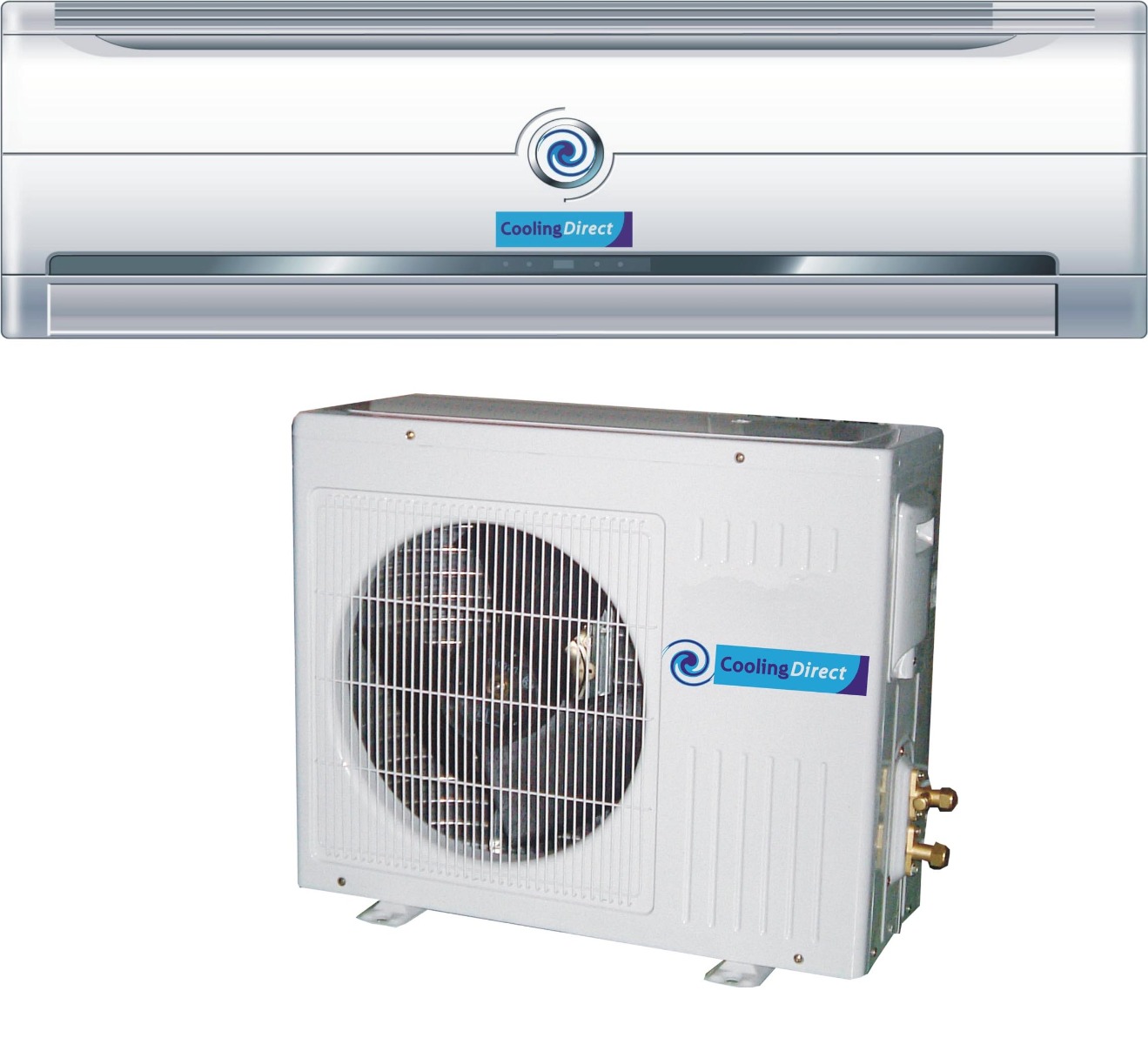 Wall mounted split air conditioner | Wall mounted air conditioner - engineer fitWall mounted split air conditioners come a variety of styles, capacities and levels of functionality. The units are engineer fit where there is no interconnecting quick connection pipes supplied with the air conditioner, which means that the installation of the wall unit and outside condenser is bespoke to building. Although the installation of these air conditioners is quite expensive, the benefit is that the installation is neat and exact to the building which inevitably raises the building's resale value. There is a far greater variety of engineer fit wall mounted air conditioners on the market compared to 'easy fit' types, therefore a wider choice of capacities, functionality and aesthetics. Wall mounted air conditioners are typically mounted at a high level (above head height) and can come with several operating modes, including heat pump, timer functionality, remote control and air purification features. Although we sell this type of air conditioner system we don't list them on our website. Phone us for help 0845 688 0112 |
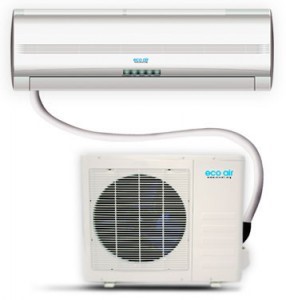 'Easy fit' split air conditioner. Regulations now require that these air conditioning types are fitted by a refrigeration engineer. | Wall mounted air conditioner - easy fitIn contrast to the engineer fit air conditioners the 'easy fit' ones are supplied with the interconnecting pipework and cable in a plastic sheath or 'umbilical cord' which has a quick connect end. The system including the pipe is pre-charged with refrigerant and is designed so that the unit can be installed be an electrician or even by someone competent in DIY. However, recent changes in regulations require that these now require fitting by a qualified refrigeration engineer. This change has meant that the choice of this type of split air conditioner has diminished, basically because if it has to be fitted by a refrigeration engineer, then they actually work out more expensive than an engineer fit machine of the type described above. This type of machine will probably disappear altogether from the market in the next year or so. All easy fit split air conditioners have a common drawback in that the 'umbilical cord' is a fixed length. This means that either it is too long and the excess length has to be 'lost' in the routing of the piping or that it is too short for the particular application intended. Before buying one of these type of air conditioners, ensure that the specified pipe length will be suitable for your application. |
 Ceiling cassette air conditioner  Ceiling suspended air conditioner | Ceiling Cassette air conditionerCommonplace in offices with suspended ceilings, the ceiling cassette air conditioner, sometimes known as a cartridge air conditioner, is usually designed to be fitted within a one or two ceiling tile spaces. The bulk of the unit is unseen as it is above the ceiling line and the only visible part is the decorative lower facing with its central inlet grille and 4 edge outlet louvers. The main advantage of these units is aesthetics, but also that a centrally mounted unit can deliver an increased cooling (or heating) capacity across a wide area because of the air being distributed in 4 directions. Typically, a single ceiling cassette air conditioner can do the same job as 3 or 4 wall mounted units. There is another type of ceiling air conditioner, which is an under ceiling air conditioner These are used where there is no suspended ceiling to install a cassette and where there is sufficient ceiling height to suspend an under ceiling unit. As these are designed to be entirely within a room, they are made to be reasonably aesthetic, however, the under ceiling air conditioners do inevitably look like overly cumbersome items to hang from a ceiling. Generally they are designed to lift air vertically into the unit and discharge treated air horizontally along the ceiling avoiding direct discharge directly onto occupants, and some allow air discharge from four sides. Although we sell this type of air conditioner system we don't list them on our website. Phone us for help 0845 688 0112 |
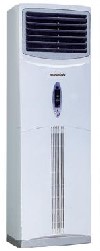 Column air conditioner 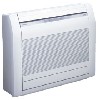 Floor mounted cabinet air conditioner | Floor mounted air conditionerFloor mounted split air conditioners can really be subdivided in to two types. Firstly column air conditioners which are large, high-capacity units (up to around 45000 BTU) used where a large room is to be cooled and where there may be building reasons why several smaller outlets cannot be used. Typical applications include lobbies, reception and waiting areas. The high output of these air conditioners means that they produce a strong flow of cool air which does not allow occupants to be in close proximity to the air conditioner. Secondly, there are smaller cabinet style air conditioners which are far smaller, more like the dimensions of a storage heater than a tall upright freezer dimensions of a column air conditioner. Typically their rated capacities are up to about 15000BTU, and they are ideal for providing high-efficiency climate control to new extensions and conservatories. These both types of air conditioners are typically installed by refrigeration engineers as they do not usually have quick connect pipes, therefore the pipe work and cabling between the inside and outside elements is installed bespoke to the building and then the system is charged with refrigerant. Although we sell this type of air conditioner system we don't list them on our website. Phone us for help 0845 688 0112 |
Duct mounted air conditioner | Duct mounted air conditionerWhere a building has a ducted air system, duct mounted air conditioning is usually the preferred option. As the ducting is usually hidden in the ceiling voids, then so to is the duct mounted air conditioning system. Sometimes known as channel or central air-conditioners they also have the advantage of being capable of delivering conditioned air to a number of rooms, depending on the air duct layout. Because these air conditioners work within duct systems, they usually have the facility of cooling fresh air or a blend of fresh and recirculated air, depending on the layout and control of the air delivery system. This type of air conditioning is common in applications where there are a number of different rooms or zones or even separate premises to be cooled. Although we sell this type of air conditioner system we don't list them on our website. Phone us for help 0845 688 0112 |
Portable or mobile air conditionersPortable split air conditioners offer the possibility or higher cooling capacity that similar size monoblocks and rated capacities for this type of air conditioner can be as high as 16000 BTU. The design typically has a plastic sheathed 'umbilical cord' containing the electrical line and the refrigerant pipes, one end of which will typically have a quick connect facility. This means that the connection between the two parts of the system can be broken to allow easy installation so that a pipe end rather than the complete external element can be passed through a window or hole in a wall. Mobile split air conditioners have the obvious advantage that they are easy to move and set up in a new room, although by putting the outside unit on mounting brackets and the umbilical cord through a drilled hole in the wall, these air conditioners can used for ''semi-permanent' installation. Larger portable splits are our speciality. Rather than have refrigerant lines the connection between the inside part and the outside is flow and return water lines. This means that although there is refrigerant in the outside bit, it is self-contained and factory sealed. The inside end is little more than a coil and fan in a box, with controls. The largest capacity unit of this type is about 50000btu, 15kw. Larger capacities are possible but the type of equipment goes on to modular chillers and air handling units. |
MULTI SPLIT AIR CONDITIONING
These air conditioning systems are essentially the same as the split systems except that there are a number of indoor units linked to the same external unit. This type of air conditioning system invariably requires a large more powerful condenser unit, however it does allow the same type of indoor unit variants for the single split systems, and even allows for different types of indoor unit being run from the same condenser, e.g. a floor mounted unit in one room, ceiling cassette in another and a wall mount in yet another room. |
 multi split air conditioner | Typically multi split systems can link between 2 and 4 internal units to a single external block. The obvious limitation of this air conditioning configuration is that if the outside block breaks down then all the internal blocks are rendered inoperative. For this reason where external space allows, a number standard split air conditioners are preferable to a multi split system. It is also the case that multi split air conditioners are seldom much more cost-effective than an equivalent configuration of standard splits. This is because the installation cost to the multi split air conditioning system is typically double that of the single splits and typically the maintenance costs are also higher. Although we sell this type of air conditioner system we don't list them on our website.Phone us for help 0845 688 0112 |
Which type to choose?
The process of choosing an air conditioner has three principal steps which in order are;
1. Work out what cooling capacity of unit you require.
2. Select the type of unit you require
3. Balance the other factors, including physical size, function, noise, aesthetics and cost before making your model selection.
The following brief pointers should help select the type of air conditioner that you need;
- For domestic and small office type applications the 'installed' choice almost always comes down to either window air conditioners or, wall or floor mounted split systems. Faced with this choice, if you can afford a wall or floor mounted split system then it is the type to choose from as usually they have more functionality and are invariably quieter than window air conditioners.
- If you have planning restrictions that prevent the placement of an external condenser on or near your building, then consider wall mounted or floor mounted monoblocks.
- If you are looking for a very efficient heating source as wall as cooling capacity then you need an air conditioners with a heat pump. This generally means that your choice is limited to split systems, although wall and floor mounted monoblocks also have heat pumps.
- If you want to have a moveable asset, for instance if you rent your property then mobiles or easy fit split air conditioners are preferable.
- For mobiles the choice is between monoblock and split units. Generally monoblocks air conditioners are more popular with split air conditioners being requested where larger capacity is required.
- For larger offices, shops, and other buildings, then the other types of air conditioning then come into play.
If you need help on solving a cooling problem or choosing an air conditioner, just ask us - 0845 688 0112.

